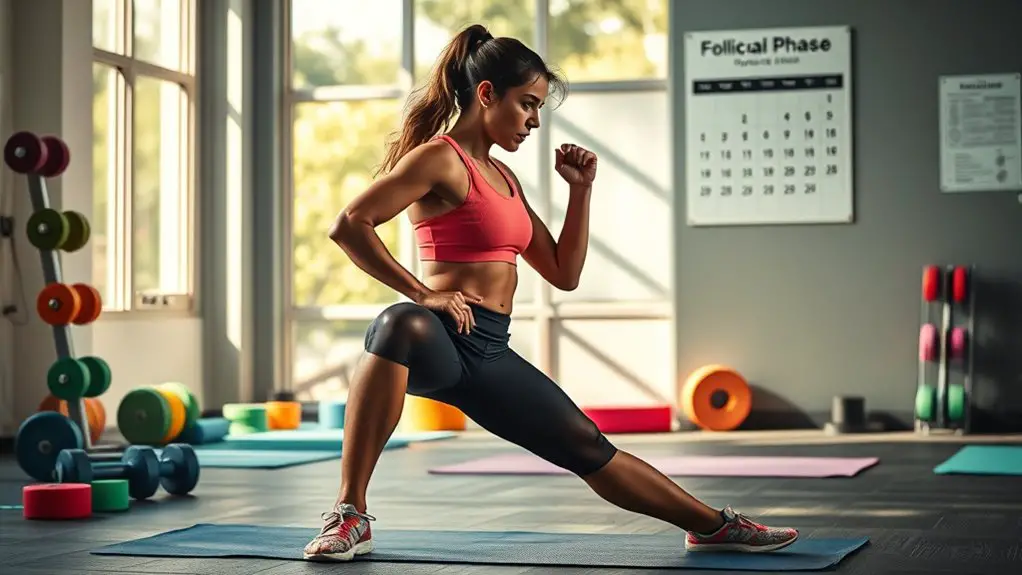How to Train During Your Menstrual Cycle

Training during your menstrual cycle can boost your performance and well-being. Listen to your body during the menstrual phase, opting for gentle exercises like yoga or walking. As you enter the follicular and ovulatory phases, ramp up intensity with strength training and high-energy workouts. In the luteal phase, adjust workouts based on your energy levels. Balance is key! By paying attention to your cycle, you’ll discover personalized strategies to optimize your workouts further.
Understanding Your Menstrual Cycle

Understanding your menstrual cycle is essential for optimizing your training regimen. Your cycle consists of various phases, each characterized by distinct hormonal changes that can impact your energy levels, mood, and performance. By tuning into these fluctuations, you can tailor your workouts for maximum effectiveness.
During the follicular phase, rising estrogen levels often boost energy and motivation, making it a great time for strength training and high-intensity workouts. As you approach ovulation, you might feel even more energetic and focused, which can enhance your performance.
Once you enter the luteal phase, hormonal shifts can lead to fatigue or mood swings. This is when you might want to adjust your training to accommodate these feelings, opting for lighter activities or restorative workouts. By understanding your menstrual cycle, you empower yourself to make informed decisions that align with your body’s needs, enhancing not only your training but also your overall wellness.
The Menstrual Phase: Training Tips
While it might seem challenging to stay active during your menstrual phase, incorporating thoughtful training strategies can make a significant difference. Your energy levels may fluctuate, and that’s okay! Here are some tips to help you navigate this phase:
Staying active during your menstrual phase is possible with mindful training strategies to accommodate your body’s needs.
- Listen to your body: Pay attention to your menstrual symptoms and adjust your workout modifications as needed. If you’re feeling fatigued, prioritize gentler activities.
- Focus on pain management: Incorporate stretching, yoga, or light cardio to alleviate cramps and discomfort.
- Choose your exercise preferences: Engage in activities that you enjoy, whether it’s walking, swimming, or a restorative yoga class, to elevate your mood during hormonal changes.
- Utilize recovery techniques: Incorporate rest days, hydration, and nutrition to support your body and enhance recovery. Regular exercise, such as skipping rope, may help alleviate period pain and cramps for some individuals.
The Follicular Phase: Optimizing Workouts

As your body shifts into the follicular phase, you’re likely to experience an increase in energy and motivation, making it an ideal time to ramp up your workouts. During this phase, your hormone levels begin to rise, which brings several follicular phase benefits, including enhanced muscle recovery and strength gains. It’s the perfect opportunity to focus on higher workout intensity.
Try incorporating strength training and cardio sessions that challenge your limits. You might find that your endurance levels improve, allowing you to push through those tough sets with greater ease. Listen to your body and adjust your workouts based on how you feel; this phase is about maximizing your potential. Incorporating cardio workouts like skipping can further boost your energy levels and mood during this phase.
Stay consistent, and remember to fuel your body with nutritious foods to support your increased activity. Embrace this energetic time, and enjoy the progress you’ll make both physically and mentally!
The Ovulatory Phase: Peak Performance
Following the follicular phase, you’ll enter the ovulatory phase, which is often marked by a peak in energy and performance. This is the perfect time to maximize your workouts and enjoy the ovulatory benefits. Here are some tips to harness that peak energy:
- High-Intensity Workouts: Engage in strength training or high-intensity interval training (HIIT) to capitalize on your increased stamina.
- Endurance Activities: Run, cycle, or swim longer distances, as your body can handle more without fatigue.
- Group Classes: Join fitness classes or group activities to enhance motivation and camaraderie.
- Skill Development: Focus on refining your skills in sports or activities you love, as your coordination and focus are heightened. Additionally, incorporating jump rope exercises can enhance your cardiovascular fitness and coordination during this phase.
The Luteal Phase: Adjusting Intensity

During the luteal phase, it’s essential to listen to your body and adjust your workout intensity accordingly. This phase often brings energy fluctuations, which can impact how you feel during exercise. It’s perfectly normal to experience a dip in energy, so consider modifying your luteal phase workouts to match your current state.
Instead of pushing through high-intensity sessions, focus on moderate workouts like brisk walking, yoga, or light strength training. These activities can help you stay active without overwhelming your body. If you feel up to it, short bursts of intense exercise can still be beneficial, but always prioritize how you’re feeling that day.
Listening to Your Body: Signs and Signals
Understanding how to adjust your workouts is just the beginning; paying attention to your body’s signals is equally important. Listening to your body enhances your body awareness and supports your emotional wellness during your menstrual cycle. Here are some signs to watch for:
Pay attention to your body’s signals to enhance awareness and emotional wellness during your menstrual cycle.
- Energy Fluctuations: Notice when you feel energized or fatigued; adapt your workouts accordingly.
- Mood Changes: Be mindful of emotional shifts; lighter activities like yoga can help.
- Physical Discomforts: If you’re experiencing cramps or pain, prioritize gentle movements and proper pain management.
- Performance Variations: Acknowledge that your performance might dip; this is normal, so adjust your goals and focus on self-care practices.
Nutrition and Hydration During Your Cycle

As you navigate your menstrual cycle, it’s important to pay attention to your nutrition and hydration, since what you eat and drink can greatly impact your energy levels and overall well-being. Implementing nutrient timing can help you optimize your workouts and recovery. Focus on consuming balanced meals rich in iron, calcium, and magnesium, especially during your period. Skipping rope can also be a fun and effective way to maintain fitness throughout your cycle and improve insulin sensitivity.
Here are some hydration strategies to keep you feeling your best:
| Phase | Nutritional Focus |
|---|---|
| Menstrual | Iron-rich foods |
| Follicular | Protein and fiber |
| Ovulatory | Antioxidant-rich foods |
| Luteal | Complex carbs and fats |
Stay hydrated throughout your cycle by drinking plenty of water and incorporating electrolyte-rich beverages. Remember, listening to your body’s needs will help you feel empowered and energized during your training!
Recovery Strategies for Each Phase
Optimizing your recovery strategies throughout your menstrual cycle can greatly enhance your training experience. Focusing on recovery techniques tailored to each phase not only helps with muscle soreness but also supports your mental wellness. Here are four key strategies:
- Rest Importance: Prioritize rest during your menstrual phase to allow your body to recover fully.
- Active Recovery: Engage in light activities like walking or yoga during the follicular phase to boost circulation and reduce stress.
- Hydration Strategies: Maintain hydration throughout your cycle, especially during ovulation when sweat loss can be higher.
- Sleep Quality: Aim for consistent, restorative sleep to improve recovery and overall performance.
Incorporating these approaches can help manage stress and optimize your training. Remember, listening to your body is essential, and adapting your recovery for each phase will keep you energized and motivated!
Building a Cycle-Savvy Workout Plan

To create a workout plan that works with your menstrual cycle, it’s essential to understand the hormonal phases your body goes through. By tailoring your exercise intensity to these phases, you can enhance your performance and recovery. Let’s explore how to align your workouts with your body’s natural rhythms for ideal results.
Understanding Hormonal Phases
Understanding your hormonal phases can be a game changer when it comes to crafting a workout plan that truly resonates with your body’s needs. By embracing cycle synchronization, you can harness hormonal fluctuations to optimize your training. Here are four key phases to reflect upon:
- Menstrual Phase: Focus on gentle exercises like yoga or walking to support your body.
- Follicular Phase: Energize your workouts with strength training and high-intensity intervals as estrogen rises.
- Ovulatory Phase: This is your peak performance time; maximize your efforts with challenging workouts.
- Luteal Phase: Shift to moderate activities and listen to your body, as energy levels may fluctuate.
Tailoring Intensity Levels
As you navigate the different phases of your menstrual cycle, tailoring the intensity of your workouts can greatly enhance your performance and overall well-being. During your menstrual phase, consider lower intensity workouts like yoga or walking; this can alleviate discomfort. As you move into the follicular phase, ramp up your intensity with strength training and cardio. When ovulation hits, you might find your energy peaks—it’s a great time for high-intensity interval training. In the luteal phase, listen to your body; this is when intensity adjustments are key. Focus on moderate workouts, and don’t hesitate to make workout modifications if needed. Embrace these changes, and you’ll likely feel more energized and empowered throughout your cycle!
Frequently Asked Questions
Can I Still Participate in High-Intensity Workouts on My Period?
Yes, you can still participate in high-intensity workouts on your period! While menstrual symptoms like cramps or fatigue might affect your energy levels, many women find that exercise helps alleviate discomfort. Listen to your body; if you feel up for it, go ahead and push yourself! Make adjustments as needed, and remember, every workout counts, regardless of your cycle. Stay motivated, and don’t hesitate to modify your routine to suit how you feel.
How Does Hormonal Birth Control Affect My Training During My Cycle?
Hormonal fluctuations from birth control can impact your training in various ways. You might notice differences in energy levels, strength, and recovery times. It’s essential to listen to your body and adjust your workouts accordingly. Some find that they can push harder during certain phases, while others may need to ease off. Staying in tune with how you feel can help you optimize your training and maintain motivation throughout your cycle.
Are There Specific Exercises to Avoid During Menstruation?
When considering exercises to avoid during menstruation, it’s best to listen to your body. Low-impact exercises like walking, yoga, or swimming can be gentle and beneficial. You might want to steer clear of high-intensity workouts that strain your pelvic floor. Remember, it’s all about finding what feels right for you. Embrace this time to nurture your body and focus on activities that bring you comfort and joy, while still keeping you active.
How Does My Cycle Impact Muscle Recovery Times?
Your cycle can considerably impact muscle recovery times. During certain phases, you might experience increased muscle soreness due to hormonal fluctuations. It’s important to adapt your recovery strategies accordingly. Focus on hydration, nutrition, and adequate rest. Incorporate gentle stretching or low-impact activities on tougher days to aid recovery. Remember, it’s okay to listen to your body and adjust your routine. Embracing these changes can help you stay motivated and feel your best throughout your cycle.
What Should I Do if I Experience Severe Cramps While Training?
You know that feeling when you’re pushing through a workout, and suddenly, cramps hit? It’s tough! For cramp management, try gentle stretching or a warm-up to ease the tension. If it’s really painful, don’t hesitate to take a break and use heat pads for pain relief. Remember, it’s okay to modify your workout based on how you feel. Your body knows best, so listen to it and prioritize your comfort!





